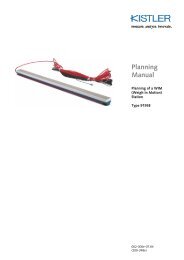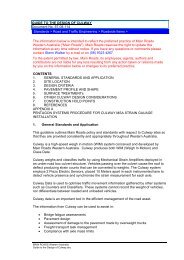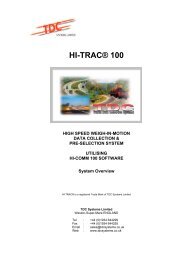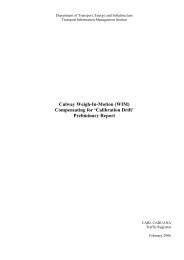AP-G84/04 Best practice in road use data collection, analysis ... - WIM
AP-G84/04 Best practice in road use data collection, analysis ... - WIM
AP-G84/04 Best practice in road use data collection, analysis ... - WIM
You also want an ePaper? Increase the reach of your titles
YUMPU automatically turns print PDFs into web optimized ePapers that Google loves.
Accessed by AR - ARRB TRANSPORT RESEARCH on <strong>04</strong> Feb 2005<br />
Aust<strong>road</strong>s 20<strong>04</strong><br />
— 64 —<br />
<strong>Best</strong> Practices <strong>in</strong> Road Use Data Collection, Analysis and Report<strong>in</strong>g<br />
<strong>AP</strong>PENDIX D – EXECUTIVE SUMMARY OF CURRENT AND FUTURE<br />
ROAD USE REPORT (RC2050-3)<br />
Scope:<br />
This Report documents a review of current and future needs for <strong>road</strong> <strong>use</strong> <strong>data</strong> cover<strong>in</strong>g the<br />
follow<strong>in</strong>g:<br />
identification of current <strong>road</strong> <strong>use</strong> <strong>data</strong> related to traffic volume and flow, traffic composition,<br />
weigh-<strong>in</strong>-motion and other <strong>road</strong> <strong>use</strong> characteristics;<br />
a discussion of the limitations of the current <strong>road</strong> <strong>use</strong> <strong>data</strong>;<br />
identification of future needs for <strong>road</strong> <strong>use</strong> <strong>data</strong> related to traffic volume and flow, traffic<br />
composition and other derived traffic parameters; and,<br />
a discussion of the issues aris<strong>in</strong>g from the capture of future <strong>road</strong> <strong>use</strong> <strong>data</strong>.<br />
This Report forms the next logical step <strong>in</strong> the process of develop<strong>in</strong>g the best <strong>practice</strong> <strong>in</strong> <strong>road</strong> <strong>use</strong><br />
<strong>data</strong> <strong>collection</strong>, <strong>analysis</strong> and its report<strong>in</strong>g.<br />
Outcomes:<br />
Current Road Use Data<br />
Current <strong>road</strong> <strong>use</strong> <strong>data</strong> <strong>collection</strong> <strong>practice</strong>s relat<strong>in</strong>g to traffic volume, flow, composition, weigh-<strong>in</strong>motion<br />
and other <strong>road</strong> characteristics across the States are <strong>in</strong>consistent beca<strong>use</strong> of differences <strong>in</strong><br />
the standards adopted, the budget allocations available, level of network coverage, specific State<br />
requirements and the technology <strong>use</strong>d.<br />
Future Road Use Data<br />
Traffic volume and flow are likely to rema<strong>in</strong> the basic <strong>in</strong>dicators of <strong>road</strong> <strong>use</strong> <strong>in</strong> the foreseeable<br />
future and it is expected that further advances <strong>in</strong> the technology available to measure volume and<br />
flow will cont<strong>in</strong>ue to evolve. Emphasis will be on improv<strong>in</strong>g measurement accuracy and vehicle<br />
classification across the network and ga<strong>in</strong><strong>in</strong>g the benefits from new technology for <strong>road</strong> <strong>use</strong> <strong>data</strong><br />
<strong>collection</strong> applications.<br />
The <strong>use</strong> of new technologies is likely to be <strong>in</strong>itially targeted towards heavily trafficked routes, major<br />
freight routes and other strategic routes of commercial or community value where the greatest<br />
potential exists to ga<strong>in</strong> additional value from the <strong>in</strong>creased knowledge of traffic flows.<br />
A <strong>road</strong> <strong>use</strong> <strong>data</strong> <strong>collection</strong> framework needs to be developed for the long-term, <strong>in</strong>clud<strong>in</strong>g storage<br />
and report<strong>in</strong>g standards and systems, implementation plans, audit and review mechanisms and<br />
long-term strategies.<br />
Improved def<strong>in</strong>ition of traffic composition through new technology will allow for greater detailed<br />
<strong>in</strong>formation about the characteristics of <strong>in</strong>dividual vehicles travell<strong>in</strong>g on the <strong>road</strong> network. This<br />
additional <strong>in</strong>formation could allow an expanded vehicle classification system to be developed. This<br />
detailed <strong>in</strong>formation could be <strong>use</strong>d for enforcement and regulatory purposes, if it is acceptable.<br />
Issues of privacy and access to this form of detailed <strong>data</strong> are likely to restrict this <strong>use</strong> of the <strong>data</strong>.

















